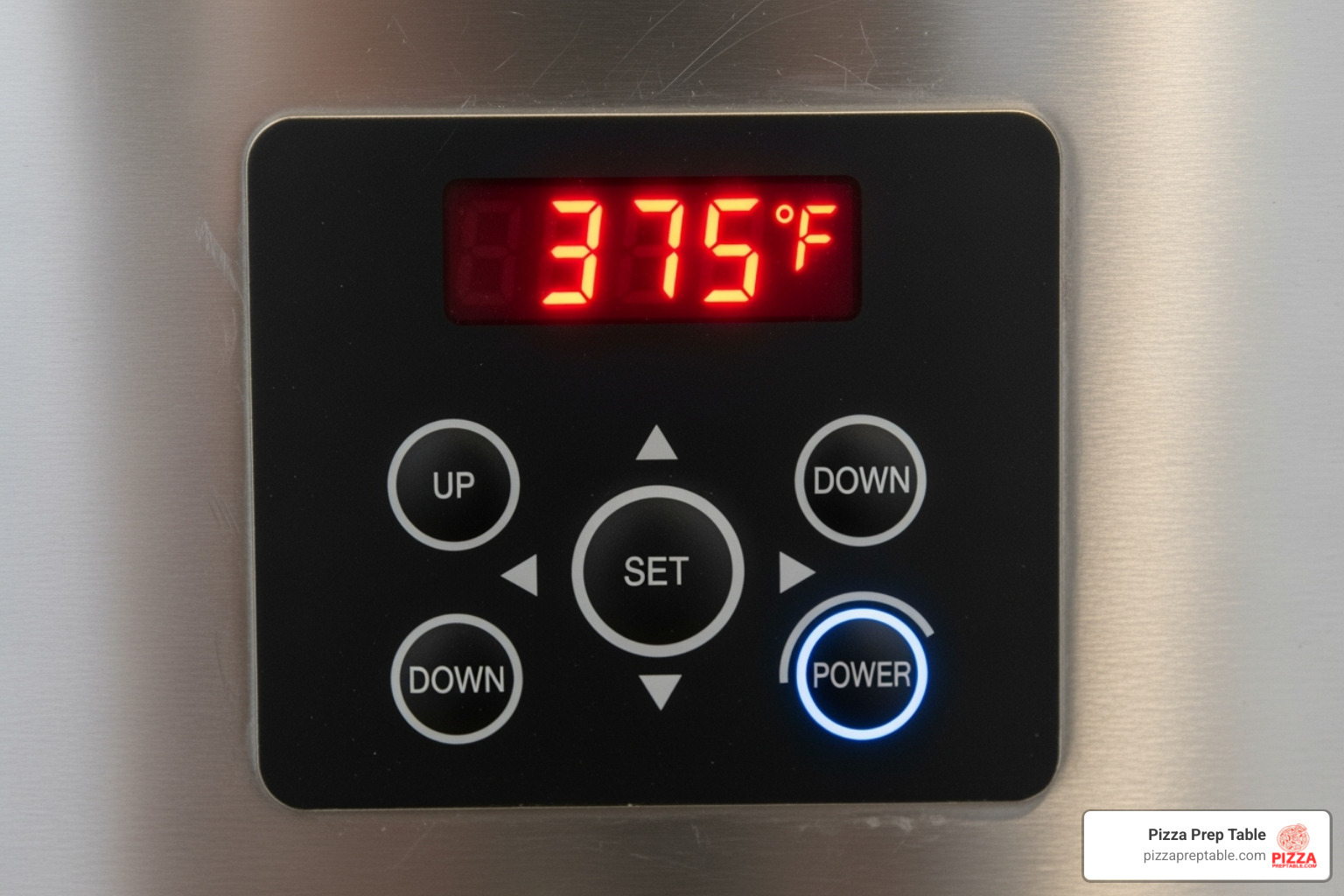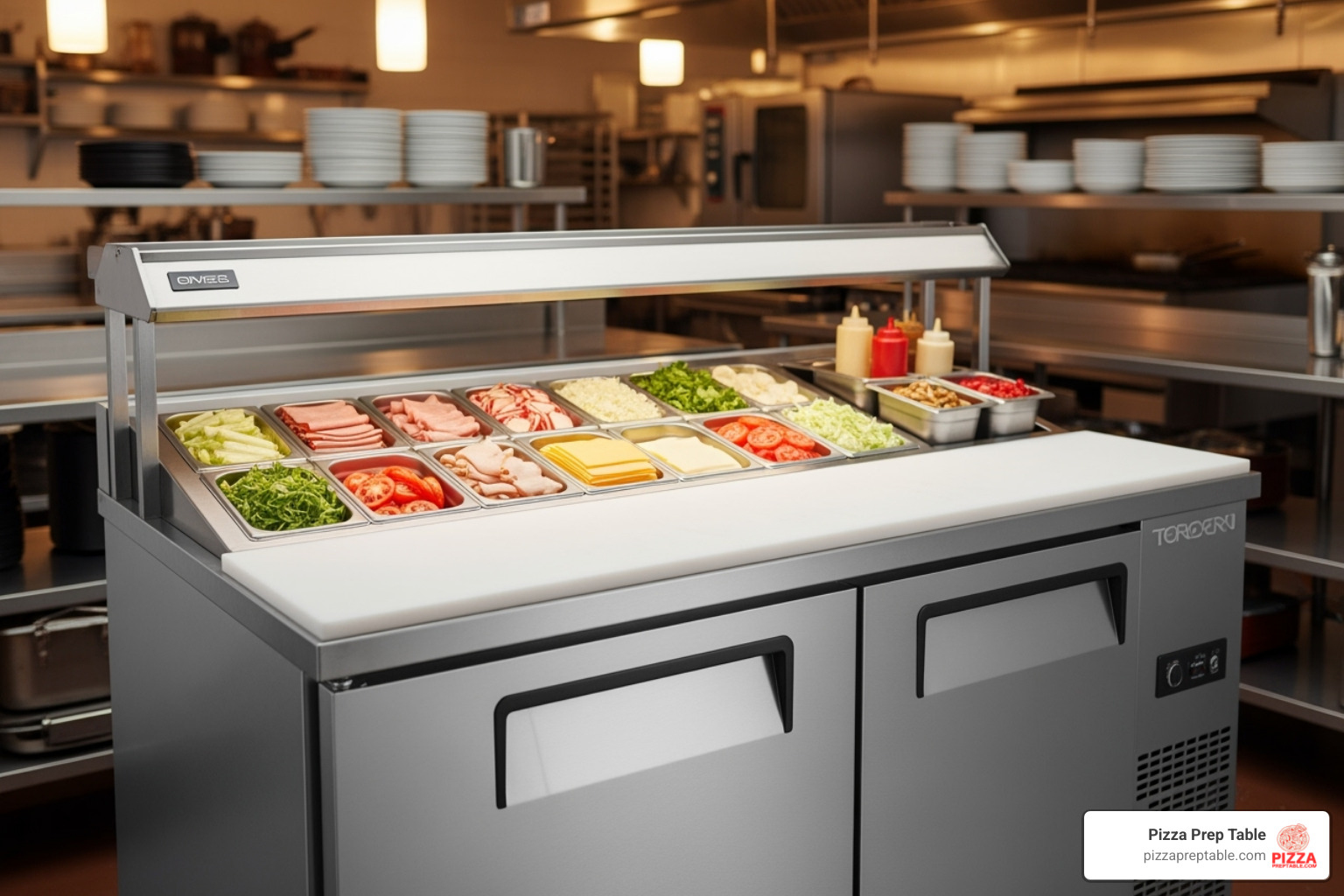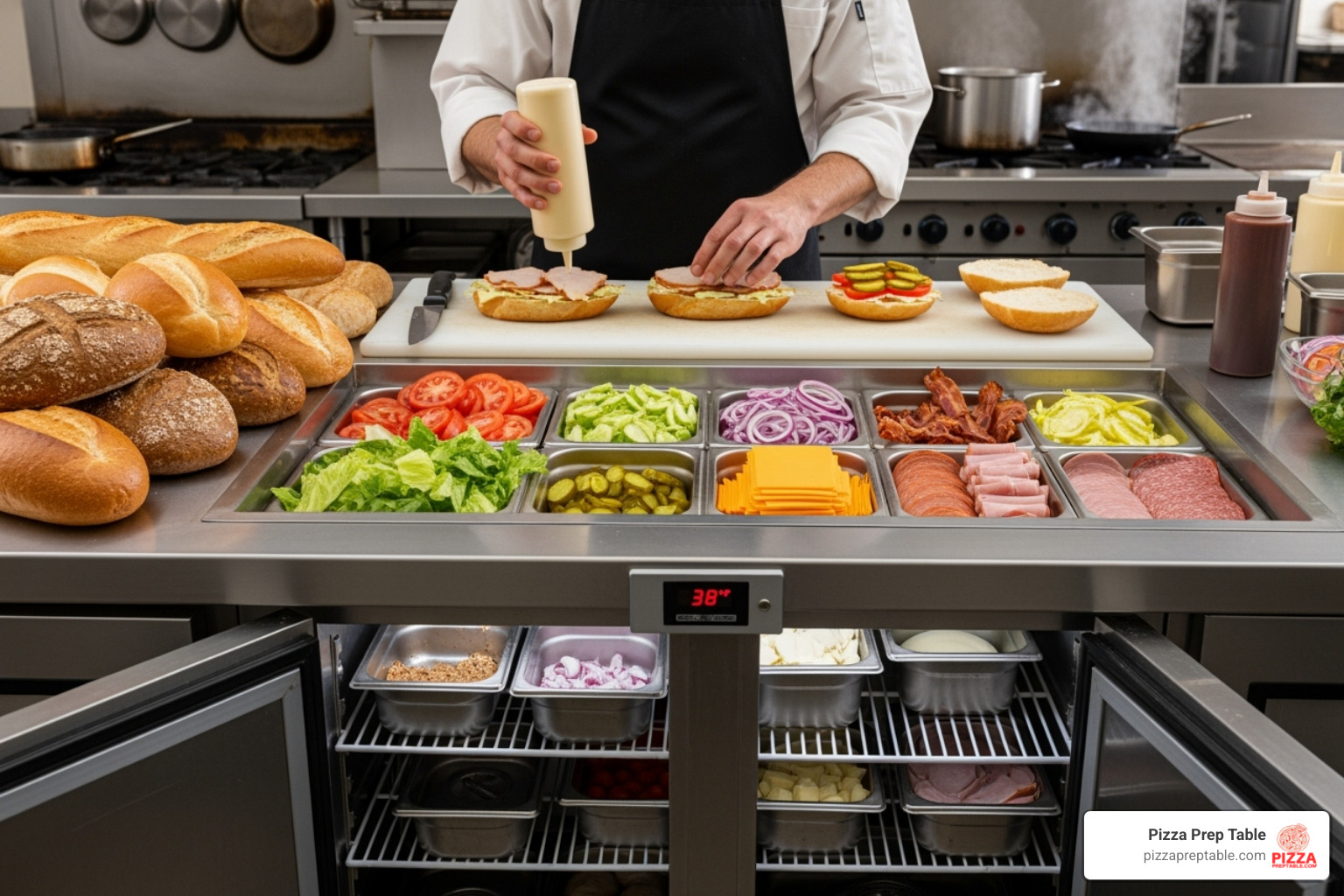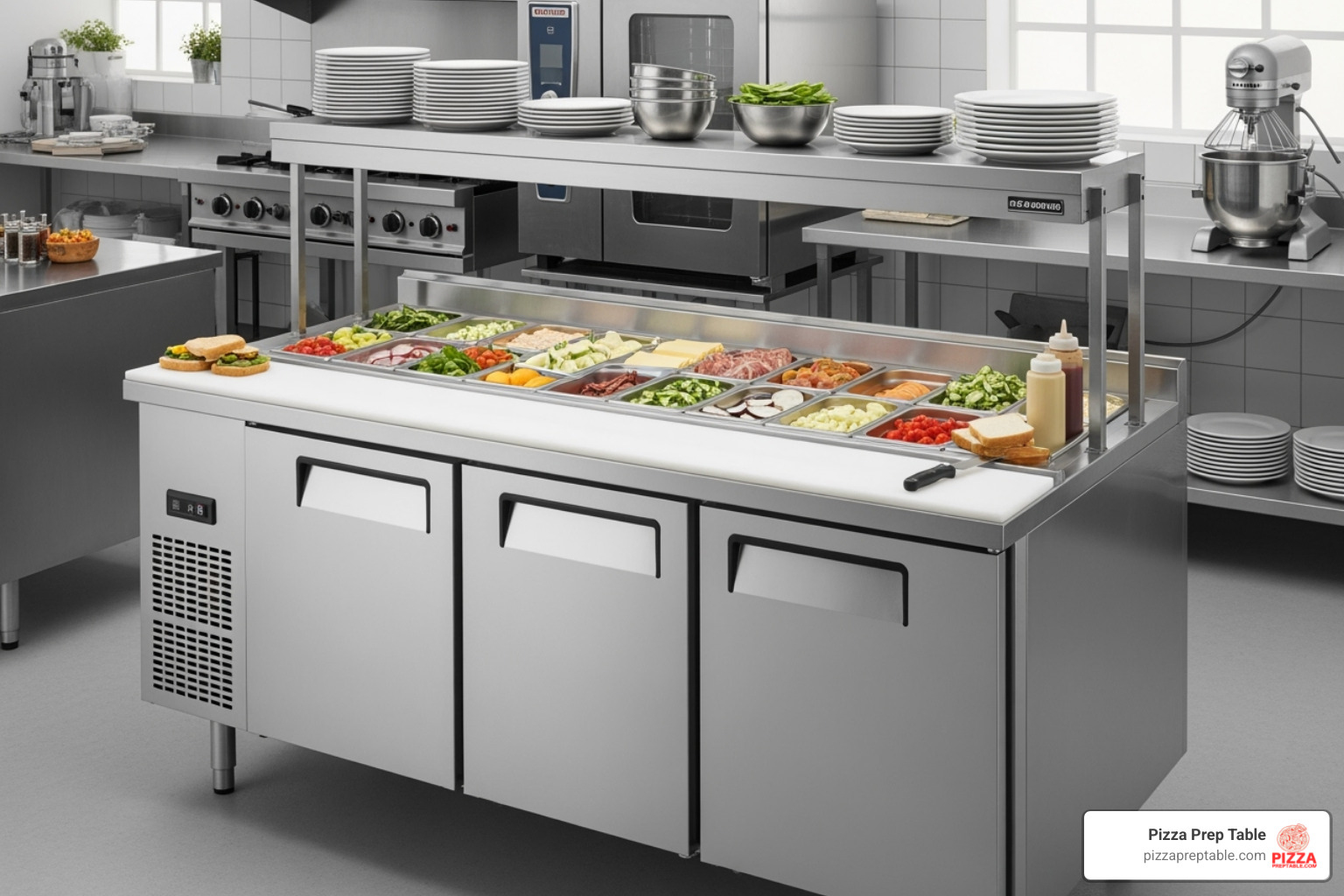
Keep Your Cool with These Sandwich Prep Table Champions
Share
Why Every Commercial Kitchen Needs a Reliable Sandwich Prep Table
A sandwich prep table is a refrigerated workstation that combines cold storage with an accessible prep surface, designed specifically for assembling sandwiches, salads, and other cold menu items efficiently.
Key Features of Sandwich Prep Tables:
- Temperature Control: Maintains ingredients below 41°F for food safety
- Integrated Storage: Refrigerated base with shelving for backup ingredients
- Pan Rail System: Holds 1/6 size food pans for easy access to toppings
- Cutting Board: Built-in workspace for food preparation
- Stainless Steel Construction: Durable, easy-to-clean materials
These versatile units serve as the backbone of efficient food prep in delis, sandwich shops, pizzerias, and restaurants of all sizes. As one Reddit user from a family golf course kitchen noted: "My first prep fridge and I love how fast I can make orders. Good amount of space underneath as well."
The combination of refrigerated storage and workspace eliminates the constant back-and-forth between walk-in coolers and prep areas, dramatically improving workflow speed while ensuring food safety compliance. Whether you're running a small café or a high-volume restaurant, the right sandwich prep table keeps ingredients fresh, organized, and within arm's reach.
I'm Sean Kearney, and my experience in restaurant equipment sales has shown me how the right sandwich prep table can transform kitchen efficiency and food safety compliance. From helping small cafes choose their first unit to outfitting large restaurant chains, I've seen how these workhorses become indispensable to successful food operations.

Quick sandwich prep table terms:
- food tables
- prep tables
Decoding the Features: What to Look for in a Top-Tier Sandwich Prep Table
Shopping for a sandwich prep table can feel overwhelming with all the technical specs and features to consider. But here's the thing – knowing what really matters will help you make a smart investment that keeps your kitchen running smoothly for years to come.
Let me walk you through the essential features that separate the champions from the wannabes.

Temperature Control: The Heart of Food Safety
This is where the magic happens – and where corners should never be cut. Your sandwich prep table needs to keep ingredients below 41°F consistently, even when you're slammed during the lunch rush.
The best units use advanced airflow systems that create what I like to call a "cool blanket of air" around your ingredients. Brands like Traulsen have perfected this with their TempAssure® technology, which prevents that annoying freezing in the back and warming in the front that cheaper units suffer from.
Look for powerful compressors and oversized cooling systems – they're your insurance policy against temperature spikes during busy periods. Most quality units operate between 33°F to 40°F, giving you that crucial safety buffer.
Consistent temperature isn't just about passing health inspections (though that's important too). It's about keeping your ingredients fresh, your customers safe, and your reputation intact.
NSF/ETL Certification: Your Seal of Approval
Here's something that's non-negotiable: NSF and ETL certifications. These aren't just fancy stickers – they're proof that your unit meets strict public health and safety standards.
NSF certification ensures the equipment is designed for easy cleaning and sanitation. ETL certification verifies electrical safety and sanitation standards for commercial use in the US and Canada.
When a health inspector walks into your kitchen, these certifications show you're serious about food safety. More importantly, they give you peace of mind that your equipment won't let you down when it matters most.
Construction Materials: Built to Last
Commercial kitchens are tough environments, and your sandwich prep table needs to be tougher. Here's what separates the workhorses from the weaklings:
The exterior should be stainless steel – specifically 430 type for durability and corrosion resistance. It looks professional, cleans easily, and won't rust or stain even after years of heavy use.
Inside, you want aluminum or 304 stainless steel construction. Stainless steel interiors with coved corners are the gold standard because they eliminate crevices where bacteria can hide. The back and bottom typically use galvanized steel for strength and cost-effectiveness.
Don't overlook foamed-in-place polyurethane insulation. This high-density insulation keeps temperatures stable, improves energy efficiency, and adds structural strength to the entire unit.
Cutting Board: Your Essential Workspace
The cutting board is where you'll spend most of your time, so it needs to work as hard as you do. Quality units use polyethylene cutting boards – they're gentle on knife blades, food-safe, and easy to sanitize.
Depth matters more than you might think. Standard boards are around 10½ to 11½ inches deep, but if you're doing high-volume prep or working with larger ingredients, consider an extra-deep 17-inch board. That extra space makes a real difference during busy periods.
The best feature? Removable cutting boards. Being able to lift off the board for thorough cleaning isn't just convenient – it's essential for maintaining proper hygiene standards.
Storage & Accessibility: Keeping Things Smooth
A great sandwich prep table doesn't just store ingredients – it organizes your entire workflow. Doors versus drawers each have their place: doors offer maximum storage with adjustable shelves (usually rated for 88-90 lbs each), while drawers provide quick access to frequently used items.
Your pan capacity determines how many ingredients you can keep at arm's reach. Smaller units hold 8-12 pans, while larger models can accommodate 24-30 standard 1/6 size pans.
Look for self-closing doors with stay-open holds. They automatically swing shut to maintain temperature but can be propped open past 90 degrees when you're loading ingredients. It's a small feature that makes a big difference during prep time.
Mobility matters too. Units with sturdy 4-inch or 5-inch locking casters let you move the table for cleaning or kitchen reconfiguration. Some even bring the unit to ADA-compliant working height.
Finally, heavy-duty pan liners might seem like a small detail, but they prevent spills from reaching the refrigeration system – protecting your investment and making cleanup much easier.
For more detailed guidance on choosing the right equipment for your kitchen, check out our comprehensive guide: More info about commercial food prep equipment.
The Main Event: Our Top Sandwich Prep Table Picks
Finding the right sandwich prep table is like choosing the perfect partner for your kitchen dance. It needs to match your rhythm, fit your space, and keep up with your busiest days. After years of helping kitchens find their perfect match, I've learned that size really does matter – but it's all about finding the right fit for your operation.
Compact Champions: The Best Sandwich Prep Table for Small Spaces (27" - 36")

Don't underestimate these little powerhouses. I've seen 27-inch units transform cramped food trucks and cozy cafes into sandwich-making machines. These compact champions prove that good things really do come in small packages.
Perfect for small independent shops, food trucks, and coffee shops expanding into lunch service, these units typically feature one door for refrigerated storage and accommodate 8 to 12 standard pans on top. One food truck owner told me, "We bought this refrigerated prep top for our food truck and it has worked very well" – and that's exactly what I love to hear.
What makes these units special is how they maximize every precious inch of kitchen space. They're also available in ADA-compliant heights, ensuring every team member can work comfortably. When you're working in tight quarters but still need professional-grade refrigeration and prep space, these compact champions deliver without compromise.
Want to see exactly what you're getting? Check out this sample 27" prep table spec sheet to understand the full capabilities of these space-saving stars.
The All-Rounders: Versatile Models for Busy Kitchens (48" - 60")

These mid-sized sandwich prep tables are the Swiss Army knives of commercial kitchens. They're what I recommend most often because they hit that sweet spot between capacity and practicality that works for so many operations.
Ideal for standard restaurants, busy delis, and catering operations, these units typically come with two doors for ample refrigerated storage and 12 to 18 pan capacity on top. The extra space means you can offer more variety without constantly restocking during busy periods.
Many models in this range feature extra-deep cutting boards – sometimes up to 15 inches – giving you serious prep space for those complex sandwich builds. The front-breathing design on many units means you can tuck them right against walls or other equipment, making the most of your kitchen layout.
One restaurant owner captured it perfectly: "This product is phenomenal and is very convenient for our restaurant as it is a great place to keep all of our product within easy access and also it keeps them cold and fresh." That's the kind of reliability that keeps kitchens running smoothly day after day.
These all-rounders give you room to grow your menu while maintaining the speed and efficiency your customers expect. A great prep table works as hard as you do, and these 48-60 inch models prove that point every single day.
High-Volume Heroes: The Ultimate Sandwich Prep Table for Large Operations (72"+)

When you're feeding hundreds of people daily, you need a sandwich prep table that's built for battle. These 72-inch-plus units are the heavy hitters designed for operations where "busy" is just another word for "Tuesday."
Perfect for large commercial kitchens, university dining halls, hospital cafeterias, and high-volume chains, these giants typically feature three doors for massive refrigerated storage and can hold 24 to 30 or more pans on the rail system. We're talking serious real estate for ingredients here.
The game-changer with these units is the dual-sided access option. Picture multiple team members working from both sides during lunch rush – it's like having two prep stations in one. Some newer models even come WiFi-enabled for remote temperature monitoring, letting you keep tabs on food safety from anywhere in your operation.
One high-volume restaurant manager summed it up perfectly: "We run a very high volume restaurant that requires our sandwich units to be reliable, easy to clean and functional. This unit does all the above very well." When you're moving fast and can't afford downtime, that reliability becomes priceless.
These high-volume heroes don't just store ingredients – they transform your entire prep workflow, turning what could be chaos into a smooth, efficient operation that keeps customers happy and staff moving at peak performance.
Mega Top vs. Standard Top: Which Configuration Wins?
When you're shopping for a sandwich prep table, one of the biggest decisions you'll face is choosing between a "Mega Top" and "Standard Top" configuration. Think of it like choosing between a sports car and an SUV – both will get you where you need to go, but they excel in different areas.
| Feature | Standard Top Sandwich Prep Table | Mega Top Sandwich Prep Table |
|---|---|---|
| Pan Configuration | Two rows of pans | Three rows of pans |
| Pan Capacity | Standard capacity | 30-50% more pan capacity |
| Cutting Board Size | Larger cutting board workspace | Smaller cutting board area |
| Best For | Simple sandwiches and basic prep | Complex sandwiches, salads, and diverse toppings |
| Workflow Style | More prep space, fewer ingredients accessible | Less prep space, maximum ingredient variety |
Standard Top models are the classic choice for good reason. With their larger cutting board workspace, they give you plenty of room to slice, dice, and assemble without feeling cramped. The two rows of pans provide easy access to your most popular ingredients while keeping things simple and organized.
If your menu focuses on straightforward sandwiches with a core set of ingredients, a Standard Top sandwich prep table might be your perfect match. The extra cutting board real estate is especially valuable during busy lunch rushes when you need space to work efficiently.
Mega Top configurations are the multitaskers of the prep table world. With three rows of pans, these units can hold 30-50% more ingredients than their standard counterparts. This extra capacity is a game-changer for operations serving complex sandwiches, elaborate salads, or diverse menu items that require numerous toppings and garnishes.
The trade-off? You'll have a smaller cutting board area to work with. But for many high-volume operations, having every ingredient within arm's reach more than makes up for the reduced prep space.
Workflow considerations play a huge role in this decision. Ask yourself: Do your staff members spend more time chopping ingredients or assembling orders? If it's the latter, a Mega Top might boost your efficiency significantly. However, if your operation involves lots of fresh prep work throughout the day, that extra cutting board space on a Standard Top could be invaluable.
Space efficiency is another factor to consider. Mega Tops pack more ingredient storage into the same footprint, making them ideal for kitchens where every square inch counts. They're particularly popular in pizza shops and sub shops where ingredient variety is key to customer satisfaction.
For more detailed guidance on selecting the right prep table configuration for your specific needs, check out our comprehensive guide: Learn how to pick the perfect kitchen prepping table.
The bottom line? Both configurations have their champions in commercial kitchens nationwide. Your choice should align with your menu complexity, available space, and workflow priorities.
